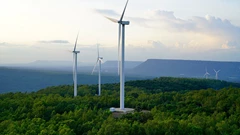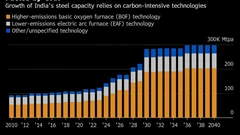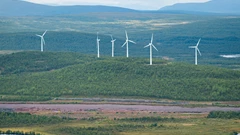Five Takeaways from the UN’s Latest 3,000-Page Climate Report
(Bloomberg) -- The UN Intergovernmental Panel on Climate Change has released its latest 3,000-page look at how humanity can avoid compounding catastrophe if nations take sufficient action to do so. So far humanity hasn’t, the report concludes. Left unchanged, the world’s current emissions trend could result in warming of more than twice the target limit set forth in the 2015 Paris Agreement of no more than 1.5° Celsius (2.7° Fahrenheit) above pre-industrial levels.
The new report updates previous work by the IPCC — its last work on this topic came out in 2014 — as well as assessing the potential of technology and offering evidence that climate action, done right, can improve the health and wellbeing of people around the world. Here are five top takeaways.
1. 1.5°C is almost out of reach
Nations, cities, businesses and investors raced to reach net-zero emissions by 2050 after the publication of a previous IPCC report in 2018. Yet according to the new report, emissions have continued to drain the “carbon budget,” an accounting tool scientists use to estimate how much time is left before temperature limits are likely to be breached. The short time that’s passed makes keeping the goal much more difficult. While “net-zero by 2050” is a slogan with breathing room, a new factoid puts the challenge into sharper focus: Global greenhouse gas emissions must peak by 2025.
2. We know what to do and have the tools to do it
More than a dozen countries have enjoyed a shrinking emissions rate for more than a decade, the panel said, with some seeing 4% annual declines consistent with a 2°C warmer world. There are cost-effective methods of cutting carbon that together could meet half the 2030 emissions target. Solar and wind costs fell 85% and 55% between 2010 and 2019, making them now cheaper than fossil-fuel-powered electricity generation in many places. Carbon-free and low carbon technologies, including nuclear and hydroelectric power, made up 37% of the electricity generated globally in 2019. The report heralds “digitalization” — robotics, AI, the internet of things — as a powerful way to increase energy efficiency and manage renewable power.
3. Carbon removal is “unavoidable” to reach net zero
Keeping to the 1.5°C or even 2°C warming limit will be increasingly difficult without going into what scientists call “overshoot,” or surpassing the limit and then clawing back down. That means carbon removal is “unavoidable” for a path to net-zero emissions, the IPCC said. There are many ways to draw down CO₂. Some of them are tested by hundreds of millions of years of evolution, like halting deforestation and regrowing dense forests. Others are new and increasingly attracting investment, such as direct-air capture that scrapes carbon right out of the air.
To fall back below the 1.5°C target by 2100, the IPCC wrote, practices and policies — many of them still embryonic — would have to draw down almost a decade of CO₂ emissions, according to scenarios that “are subject to increased feasibility concerns.”
4. Behavior matters
Climate scientists use the term mitigation to encompass all the ways that the causes of climate change can be tamped down. For the first time in an IPCC study focusing on these prevention methods, scientists looked at carbon-cutting from the demand side. Scaled behavioral and cultural changes, they found, can wring out 40 to 70% of emissions compared with recent trends. Beef consumption, air travel and building energy use are all areas where the combined decisions of many people can have a substantial impact.
Social science has rarely been a part of the IPCC process, but that changed as authors reviewed 100,000 relevant papers generated in recent years from those disciplines. The new report chapter dovetails with recent analyses quantifying just how much more wealthy people emit than everyone else: The top 1% of emitters are responsible for 70 times more pollution than people in the bottom 50%.
5. Politics shapes the process
Media coverage of IPCC releases tends to focus on what’s called the “summary for policymakers,” a condensed version of the doorstop assessment. Every line of this document must be agreed on by delegates from 195 countries and the scientists who wrote the report. The approval session for the latest report lasted two weeks and was held virtually with hundreds of participants. Wrangling toward the end led to a 40-hour weekend sprint to push the report through the approval process. The IPCC’s work is scientific, but this layer of geopolitics leads to competition over every word, as negotiators to try to embed in final language protections of their own national interests. Although the summary must always reflect the science in the longer report, they don’t always match perfectly.
Sometimes, scientists lay bare a core problem in a way that diplomats never would. Such as when they write: “The interaction between politics, economics and power relationships is central to explaining why broad commitments do not always translate to urgent action.”
More stories like this are available on bloomberg.com
©2022 Bloomberg L.P.
KEEPING THE ENERGY INDUSTRY CONNECTED
Subscribe to our newsletter and get the best of Energy Connects directly to your inbox each week.
By subscribing, you agree to the processing of your personal data by dmg events as described in the Privacy Policy.
More renewables news

Longi Delays Solar Module Plant in China as Sector Struggles

SSE Plans £22 Billion Investment to Bolster Scotland’s Grid

A Booming and Coal-Heavy Steel Sector Risks India’s Green Goals

bp and JERA join forces to create global offshore wind joint venture

Blackstone’s Data-Center Ambitions School a City on AI Power Strains

Chevron Is Cutting Low-Carbon Spending by 25% Amid Belt Tightening

Free Green Power in Sweden Is Crippling Its Wind Industry

California Popularized Solar, But It's Behind Other States on Panels for Renters

A $50 Billion London Investor Takes a Contrarian View on Trump
















